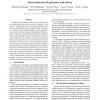Free Online Productivity Tools
i2Speak
i2Symbol
i2OCR
iTex2Img
iWeb2Print
iWeb2Shot
i2Type
iPdf2Split
iPdf2Merge
i2Bopomofo
i2Arabic
i2Style
i2Image
i2PDF
iLatex2Rtf
Sci2ools
MICRO
2002
IEEE
2002
IEEE
Microarchitectural exploration with Liberty
To find the best designs, architects must rapidly simulate many design alternatives and have confidence in the results. Unfortunately, the most prevalent simulator construction methodology, hand-writing monolithic simulators in sequential programming languages, yields simulators that are hard to retarget, limiting the number of designs explored, and hard to understand, instilling little confidence in the model. Simulator construction tools have been developed to address these problems, but analysis reveals that they do not address the root cause, the error-prone mapping between the concurrent, structural hardware domain and the sequential, functional software domain. This paper presents an analysis of these problems and their solution, the Liberty Simulation Environment (LSE). LSE automatically constructs a simulator from a machine description that closely resembles the hardware, ensuring fidelity in the model. Furthermore, through a strict but general component communication cont...
| Added | 15 Jul 2010 |
| Updated | 15 Jul 2010 |
| Type | Conference |
| Year | 2002 |
| Where | MICRO |
| Authors | Manish Vachharajani, Neil Vachharajani, David A. Penry, Jason A. Blome, David I. August |
Comments (0)

